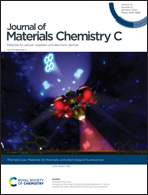Effective models for TADF: the role of the medium polarizability†
Abstract
A novel approch to estimate intersystem and reverse intersystem crossing rates (ISC and RISC rates, respectively) is proposed. We build on an effective model Hamiltonian recently parametrized ab initio and validated experimentally for a prototypical dye for thermally activated delayed fluorescence (TADF). The model describes the relevant physics in terms of a few diabatic states coupled to an effective vibrational coordinate and an effective conformational mode. A complete, numerically exact, non-adiabatic solution of the problem opens the way to the calculation of ISC and RISC rates fully accounting for the anharmonic and non-adiabatic nuclear dynamics. The model is further extended to address the role of the environmental polarizability, as described by the medium refractive index. The marginal variability of the refractive index in organic media results in marginal effects on the rates in different media. However, large variations of the rates are predicted when moving from the gas phase to an organic medium, suggesting that a meaningful analysis of experimental data must rely on computational analysis properly accounting for the dielectric properties of the surrounding medium.

- This article is part of the themed collection: Materials for thermally activated delayed fluorescence and/or triplet fusion upconversion


 Please wait while we load your content...
Please wait while we load your content...